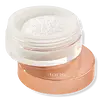Mac Cosmetics Studio Fix Powder Plus Foundation Versus Tarte Smooth Operator Amazonian Clay Finishing Powder
What's inside
What's inside
 Key Ingredients
Key Ingredients

 Benefits
Benefits

 Concerns
Concerns

 Ingredients Side-by-side
Ingredients Side-by-side

Synthetic Fluorphlogopite
Magnesium Potassium Fluorosilicate
AbrasiveBoron Nitride
AbsorbentAluminum Starch Octenylsuccinate
AbsorbentAluminum Hydroxide
EmollientOctyldodecyl Stearoyl Stearate
EmollientHydrogenated Vegetable Oil
EmollientSilica
AbrasiveDimethicone
EmollientIllite
AbrasiveZinc Stearate
Cosmetic ColorantDicalcium Phosphate
AbrasivePentaerythrityl Tetraisostearate
EmollientSilybum Marianum Seed Oil
Skin ConditioningNannochloropsis Oculata Extract
HumectantAlaria Esculenta Extract
Skin ProtectingPorphyra Umbilicalis Extract
Skin ConditioningRosa Hybrid Flower Extract
Skin ConditioningCaprylic/Capric Triglyceride
MaskingCaprylyl Glycol
EmollientBisabolol
MaskingEthylhexylglycerin
Skin ConditioningKaolin
AbrasiveMica
Cosmetic ColorantTriethoxycaprylylsilane
Sorbitan Tristearate
EmulsifyingPentaerythrityl Tetra-Di-T-Butyl Hydroxyhydrocinnamate
AntioxidantTocopherol
AntioxidantCI 77891
Cosmetic ColorantCI 77491
Cosmetic ColorantCI 77492
Cosmetic ColorantCI 77499
Cosmetic ColorantCI 77163
Cosmetic ColorantCI 77289
Cosmetic ColorantCI 77288
Cosmetic ColorantCI 77510
Cosmetic ColorantCI 77742
Cosmetic ColorantCI 15850
Cosmetic ColorantCI 77007
Cosmetic ColorantCI 42090
Cosmetic ColorantCI 45410
Cosmetic ColorantCI 73360
Cosmetic ColorantCI 19140
Cosmetic ColorantCI 15985
Cosmetic ColorantSynthetic Fluorphlogopite, Magnesium Potassium Fluorosilicate, Boron Nitride, Aluminum Starch Octenylsuccinate, Aluminum Hydroxide, Octyldodecyl Stearoyl Stearate, Hydrogenated Vegetable Oil, Silica, Dimethicone, Illite, Zinc Stearate, Dicalcium Phosphate, Pentaerythrityl Tetraisostearate, Silybum Marianum Seed Oil, Nannochloropsis Oculata Extract, Alaria Esculenta Extract, Porphyra Umbilicalis Extract, Rosa Hybrid Flower Extract, Caprylic/Capric Triglyceride, Caprylyl Glycol, Bisabolol, Ethylhexylglycerin, Kaolin, Mica, Triethoxycaprylylsilane, Sorbitan Tristearate, Pentaerythrityl Tetra-Di-T-Butyl Hydroxyhydrocinnamate, Tocopherol, CI 77891, CI 77491, CI 77492, CI 77499, CI 77163, CI 77289, CI 77288, CI 77510, CI 77742, CI 15850, CI 77007, CI 42090, CI 45410, CI 73360, CI 19140, CI 15985
 Reviews
Reviews

Ingredients Explained
These ingredients are found in both products.
Ingredients higher up in an ingredient list are typically present in a larger amount.
Caprylyl Glycol is a humectant and emollient, meaning it attracts and preserves moisture.
It is a common ingredient in many products, especially those designed to hydrate skin. The primary benefits are retaining moisture, skin softening, and promoting a healthy skin barrier.
Though Caprylyl Glycol is an alcohol derived from fatty acids, it is not the kind that can dry out skin.
This ingredient is also used as a preservative to extend the life of products. It has slight antimicrobial properties.
Learn more about Caprylyl GlycolEthylhexylglycerin (we can't pronounce this either) is commonly used as a preservative and skin softener. It is derived from glyceryl.
You might see Ethylhexylglycerin often paired with other preservatives such as phenoxyethanol. Ethylhexylglycerin has been found to increase the effectiveness of these other preservatives.
Kaolin is a clay. It is used for oil control and to help minimize pores. Like other clays, kaolin has the ability to absorb excess sebum or oil. This can help clean out pores and mattify the skin.
Some types of kaolin may have exfoliating properties. When water is added to kaolin, it becomes a paste with small abrasive particles.
Most kaolin is a white color, but may be pink/orange/red depending on where it comes from.
The name 'kaolin' comes from a Chinese village named 'Gaoling'. Kaolin clay comes from rocks rich in kaolinite. Kaolinite, the mineral, has a silicate layered structure. Kaolinite is formed from chemical weathering of aluminum siilicate minerals.
Besides skincare, kaolin is commonly used to make glossy paper, in ceramics, toothpaste, and as medicine to soothe stomach issues.
Learn more about KaolinSilica, also known as silicon dioxide, is a naturally occurring mineral. It is used as a fine, spherical, and porous powder in cosmetics.
Though it has exfoliant properties, the function of silica varies depending on the product.
The unique structure of silica enhances the spreadability and adds smoothness, making it a great texture enhancer.
It is also used as an active carrier, emulsifier, and mattifier due to its ability to absorb excess oil.
In some products, tiny microneedles called spicules are made from silica or hydrolyzed sponge. When you rub them in, they lightly polish away dead skin layers and enhance the penetration of active ingredients.
Learn more about SilicaTocopherol (also known as Vitamin E) is a common antioxidant used to help protect the skin from free-radicals and strengthen the skin barrier. It's also fat soluble - this means our skin is great at absorbing it.
Vitamin E also helps keep your natural skin lipids healthy. Your lipid skin barrier naturally consists of lipids, ceramides, and fatty acids. Vitamin E offers extra protection for your skin’s lipid barrier, keeping your skin healthy and nourished.
Another benefit is a bit of UV protection. Vitamin E helps reduce the damage caused by UVB rays. (It should not replace your sunscreen). Combining it with Vitamin C can decrease sunburned cells and hyperpigmentation after UV exposure.
You might have noticed Vitamin E + C often paired together. This is because it is great at stabilizing Vitamin C. Using the two together helps increase the effectiveness of both ingredients.
There are often claims that Vitamin E can reduce/prevent scarring, but these claims haven't been confirmed by scientific research.
Learn more about Tocopherol